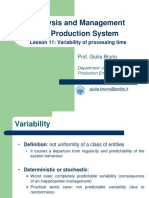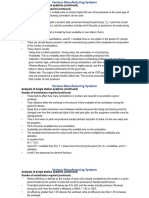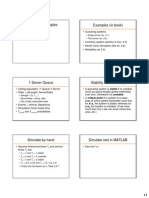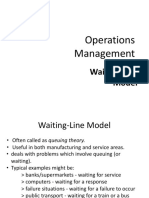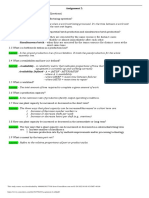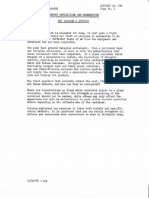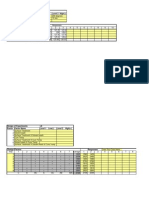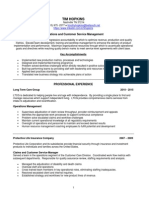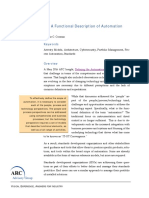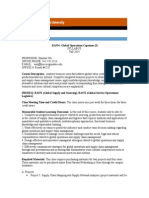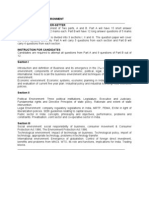Stanley 2
Stanley 2
Uploaded by
Deepak PathaniaCopyright:
Available Formats
Stanley 2
Stanley 2
Uploaded by
Deepak PathaniaOriginal Description:
Original Title
Copyright
Available Formats
Share this document
Did you find this document useful?
Is this content inappropriate?
Copyright:
Available Formats
Stanley 2
Stanley 2
Uploaded by
Deepak PathaniaCopyright:
Available Formats
LESSON 2.2 Dynamics of Manufacturing Systems Topics 1. Variability and how to measure it 2.
Propagation of variability within manufacturing system and how to model it 3. Impacts of variability 4. Countermeasures against variability Guiding questions What is variability of manufacturing system and how to measure it? How to model and analyze variability of manufacturing systems? How to reduce variability and its impacts? Factory Dynamics Definition: A manufacturing system is a goal-oriented network of processes through which parts flow. Structure: Plant is made up of routings (lines), which in turn are made up of processes. Focus: Factory Dynamics is concerned with the network and flows at the routing (line) level.
Parameters Descriptors of a Line: 1. Bottleneck Rate (rb):Rate (parts/unit time or jobs/unit time) of the process center having the highest long-termutilization. 2. Raw Process Time (T0):Sum of the long-term averageprocess times of each station in the line. Relationship: Critical WIP (W0): WIP level in which a line having no congestion would achieve maximum throughput (i.e., rb) with minimum cycle time (i.e., T0). W0= rbT0 Variability Makes a Difference! Littles Law: TH = WIP/CT, so same throughput can be obtained with large WIP, long CT or small WIP, short CT. The difference? Penny Fab One: achieves full TH (0.5 j/hr) at WIP=W0=4 jobs if it behaves like Best Case, but requires WIP=27 jobs to achieve 95% of capacity if it behaves like the Practical Worst Case. Why? Tortise and Hare Example Two machines: subject to same workload: 69 jobs/day (2.875 jobs/hr) subject to unpredictable outages (availability = 75%) Hare X19: long, but infrequent outages
Tortoise 2000: short, but more frequent outages Performance: Hare X19 is substantially worse on all measures than Tortoise 2000. Why? Variability Views Variability: Any departure from uniformity Random versus controllable variation Randomness: Essential reality? Artifact of incomplete knowledge? Management implications: robustness is key Probabilistic Intuition Uses of Intuition: driving a car throwing a ball mastering the stock market First Moment Effects: Throughput increases with machine speed Throughput increases with availability Inventory increases with lot size Our intuition is good for first moments Second Moment Effects: Which is more variable processing times of parts or batches? Which are more disruptive long, infrequent failures or short frequent ones? Our intuition is less secure for second moments Misinterpretation e.g., regression to the mean Variability Definition: Variability is anything that causes the system to depart from regular, predictable behavior. Sources of Variability: setups machine failures materials shortages yield loss rework operator unavailability workplace variation differential skill levels engineering change orders customer orders product differentiation
material handling
Measuring Process Variability te = mean process time of a job e = standard deviation of process time ce = e /te = coefficient of variation, CV Note: we often use the squared coefficient of variation (SCV),ce2 Variability Classes in Factory Dynamics
Effective Process Times: actual process times are generally LV effective process times include setups, failure outages, etc. HV, LV, and MV are all possible in effective process times Relation to Performance Cases: For balanced systems MV Practical Worst Case LV between Best Case and Practical Worst Case HV between Practical Worst Case and Worst Case Measuring Process Variability Example
Natural Variability Definition: variability without explicitly analyzed cause Sources: operator pace material fluctuations
product type (if not explicitly considered) product quality Observation: natural process variability is usually in the LV category. Down Time Mean Effects Definitions: to = base process time co = base process time coefficient of variability ro = 1/to = base capacity (rate, e.g., parts/hr) mf = mean time to failure mr = mean time to repair cr = coefficient of variability of repair times (r / mr) Availability: Fraction of time machine is up
Effective Processing Time and Rate: re = A r o te = to / A Totoise and Hare -Availability Hare X19: t0 = 15 min 0 = 3.35 min c0 = 0/t0= 3.35/15 = 0.05 mf = 12.4 hrs (744 min) mr = 4.133 hrs (248 min) cr = 1.0 Tortoise: t0 = 15 min 0 = 3.35 min c0 = .0/t0= 3.35/15 = 0.05 mf = 1.9 hrs (114 min) mr = 0.633 hrs (38 min) cr = 1.0 Down Time Variability Effects Effective Variability:
Conclusions: Failures inflate mean, variance, and CV of effective process time Mean (te) increases proportionally with 1/A SCV (ce2) increases proportionally with mr SCV (ce2) increases proportionally in cr2 For constant availability (A), long infrequent outages increase SCV more than short frequent ones Tortoise and Hare -Variability Hare X19: te = ce2 = Tortoise 2000 te = ce2 = Setups Mean and Variability Effects Analysis: Ns = average no. jobs between setups ts = average setup duration s = standard deviation of setup time
Observations: Setups increase mean and variance of processing times. Variability reduction is one benefit of flexible machines. However, the interaction is complex.
Setup Example Data: Fast, inflexible machine 2 hr setup every 10 jobs to = 1 hr Ns = 10 jobs/setup ts = 2 hrs te = to + ts /Ns = 1 + 2/10 = 1.2 hrs re = 1/te = 1/(1+2/10) = 0.8333 Slower, flexible machine no setups to = 1.2 hrs re = 1/to = 1/1.2 = o.833 jobs/hr Traditional Analysis? Factory Dynamics Approach: Compare mean and variance Fast, inflexible machine 2 hr setup every 10 jobs
Slower, flexible machine no setups to = 1.2 hrs co2 = 0.25 re = 1/to = 1/1.2 = 0.833 jobs/hr ce2 = co2 = 0.25 Conclusion: New Machine: Consider a third machine same as previous machine with setups, but with shorter, more frequent setups Ns = 5 jobs/setup ts = 1 hr Analysis:
Conclusion: Other Process Variability Inflators Sources: operator unavailability recycle batching material unavailability et cetera, et cetera, et cetera Effects: inflate te inflate ce Consequences: Illustrating Flow Variability Low variability arrivals High variability arrivals
Measuring Flow Variability ta = mean time between arrivals ra = 1/ta = arrival rate a = standard deviation of time between arrivals ca = a / ta = coefficient of variation of interarrival times Propagation of Variability
Single Machine Station:
where u is the station utilization given by u= rate departure var depends on arrival var and process var Multi-Machine Station:
where m is the number of (identical) machines and
Propagation of Variability High Utilization Station
Conclusion: flow variability out of a high utilization station is determined primarily by process variability at that station. Propagation of Variability Low Utilization Station
Conclusion: flow variability out of a low utilization station is determined primarily by flow variability into that station. Variability Interactions Importance of Queueing: manufacturing plants are queueing networks queueing and waiting time comprise majority of cycle time System Characteristics: Arrival process Service process Number of servers Maximum queue size (blocking)
Service discipline (FCFS, LCFS, etc.) Balking Routing Many more
Kendall's Classification A/B/C A: arrival process B: service process C: number of machines M: exponential (Markovian) distribution G: completely general distribution D: constant (deterministic) distribution. Queueing Parameters ra = the rate of arrivals in customers (jobs) per unit time (ta= 1/ra= average time between arrivals) ca = CV of inter-arrival times. m = number of machines. re = rate of the station in jobs per unit time = m/te. ce= CV of effective process times. Note: a station can be described by 5 parameters. u = utilization of station = ra/re. Queueing Measures Measures: CTq = the expected waiting time spent in queue. CT = the expected time spent at the process center, i.e., queue time plus process time. WIP = the average WIP level (in jobs) at the station. WIPq = the expected WIP (in jobs) in queue. Relationships: CT = CTq + te WIP = ra x CT WIPq = ra x CTq Result: If we know CTq, we can compute WIP, WIPq, CT. The G/G/1 Queue Formula:
Observations: Useful model of single machine workstations Separate terms for variability, utilization, process time. CTq (and other measures) increase with ca2and ce2 Flow variability, process variability, or both can combine to inflate queue time.
Variability causes congestion!
The G/G/m Queue Formula:
Observations: Useful model of multi-machine workstations Extremely general. Fast and accurate. Easily implemented in a spreadsheet (or packages like MPX). VUT Spreadsheet
Effects of Blocking VUT Equation: characterizes stations with infinite space for queueing useful for seeing what will happen to WIP, CT without restrictions But real world systems often constrain WIP: physical constraints (e.g., space or spoilage) logical constraints (e.g., kanbans) Blocking Models: estimate WIP and TH for given set of rates, buffer sizes
much more complex than non-blocking (open) models, often require simulation to evaluate realistic systems
The M/M/1/b Queue
Note: there is room for b=B+2 jobs in system, B in the buffer and one at each station. Model of Station 2
Blocking Example
Seeking Out Variability General Strategies: look for long queues (Little's law) look for blocking focus on high utilization resources consider both flow and process variability
ask why five times Specific Targets: equipment failures setups rework operator pacing anything that prevents regular arrivals and process times Variability Pooling Basic Idea: the CV of a sum of independent random variables decreases with the number of random variables. Example (Time to process a batch of parts):
Safety Stock Pooling Example PCs consist of 6 components (CPU, HD, CD ROM, RAM, removable storage device, keyboard) 3 choices of each component: 36= 729 different PCs Each component costs 150 (900 material cost per PC) Demand for all models is normally distributed with mean 100 per year, standard deviation 10 per year Replenishment lead time is 3 months, so average demand during LT is = 25for computers and = 25x(729/3) = 6075 for components Use base stock policy with fill rate of 99% Pooling Example -Stock PCs Base Stock Level for Each PC:
On-Hand Inventory for Each PC: Total (Approximate) On-Hand Inventory : 12 x 729 x 900 = 7,873,200
Pooling Example -Stock Components Necessary Service for Each Component: S = (0.99)1/6 = 0.9983 -> zs = 2.93 Base Stock Level for Each Component:
On-Hand Inventory Level for Each Component: Total Safety Stock: 228 x 18 x 150 = 615,600 92% reduction! Basic Variability Takeaways Variability Measures: CV of effective process times CV of interarrival times Components of Process Variability failures setups many others -deflate capacity and inflate variability long infrequent disruptions worse than short frequent ones Consequences of Variability: variability causes congestion (i.e., WIP/CT inflation) variability propagates variability and utilization interact pooled variability less destructive than individual variability Performance of a Serial Line Measures: Throughput Inventory (RMI, WIP, FGI) Cycle Time Lead Time Customer Service Quality Evaluation: Comparison to perfect values (e.g., rb, T0) Relative weights consistent with business strategy? Links to Business Strategy: Would inventory reduction result in significant cost savings? Would CT (or LT) reduction result in significant competitive advantage? Would TH increase help generate significantly more revenue? Would improved customer service generate business over the long run? Influence of Variability
Variability Law: Increasing variability always degrades the performance of a production system. Examples: process time variability pushes best case toward worst case higher demand variability requires more safety stock for same level of customer service higher cycle time variability requires longer lead time quotes to attain same level of on-time delivery Variability Buffering Buffering Law: Systems with variability must be buffered by some combination of: 1. inventory 2. capacity 3. time. Interpretation: If you cannot pay to reduce variability, you will pay in terms of high WIP, under-utilized capacity, or reduced customer service (i.e., lost sales, long lead times, and/or late deliveries). Variability Buffering Examples Ballpoint Pens: cant buffer with time (who will backorder a cheap pen?) cant buffer with capacity (too expensive, and slow) must buffer with inventory Ambulance Service: cant buffer with inventory (stock of emergency services?) cant buffer with time (violates strategic objectives) must buffer with capacity Organ Transplants: cant buffer with WIP (perishable) cant buffer with capacity (ethically anyway) must buffer with time Simulation Studies TH Constrained System (push)
WIP Constrained System (pull)
Variability in Push Systems
Notes: ra= 0.8, ca = ce(i) in all cases. B(i) = , i = 1-4 in all cases. Observations: TH is set by release rate in a push system. Increasing capacity (rb) reduces need for WIP buffering. Reducing process variability reduces WIP for same TH, reduces CT for same TH, and reduces CT variability. Variability in Pull Systems
Notes: Station 1 pulls in job whenever it becomes empty. B(i) = 0, i= 1, 2, 4 in all cases, except case 6, which has B(2) = 1. Observations: Capping WIP without reducing variability reduces TH. WIP cap limits effect of process variability on WIP/CT.
Reducing process variability increases TH, given same buffers. Adding buffer space at bottleneck increases TH. Magnitude of impact of adding buffers depends on variability. Buffering less helpful at non-bottlenecks. Reducing process variability reduces CT variability. Conclusion: consequences of variability are different in push and pull systems, but in either case the buffering law implies that you will pay for variability somehow. Example Discrete Parts Flowline
Inventory Buffers: raw materials, WIP between processes, FGI Capacity Buffers: overtime, equipment capacity, staffing Time Buffers: frozen zone, time fences, lead time quotes Variability Reduction: smaller WIP & FGI , shorter cycle times Example Batch Chemical Process
Inventory Buffers: raw materials, WIP in tanks, finished goods Capacity Buffers: idle time at reactors Time Buffers: lead times in supply chain Variability Reduction: WIP is tightly constrained, so target is primarily throughput improvement, and maybe FGI reduction. Example Moving Assembly Line
Inventory Buffers: components, in-line buffers Capacity Buffers: overtime, rework loops, warranty repairs Time Buffers: lead time quotes Variability Reduction: initially directed at WIP reduction, but later to achieve better use of capacity (e.g., more throughput) Buffer Flexibility Buffer Flexibility Corollary: Flexibility reduces the amount of variability buffering required in a production system. Examples: Flexible Capacity: cross-trained workers Flexible Inventory: generic stock (e.g., assemble to order) Flexible Time: variable lead time quotes Variability from Batching VUT Equation: CT depends on process variability andflow variability Batching: affects flow variability affects waiting inventory Conclusion: batching is an important determinant of performance Process Batch Versus Move Batch Dedicated Assembly Line: What should the batch size be? Process Batch: Related to length of setup. The longer the setup the larger the lot size required for the same capacity. Move (transfer) Batch: Why should it equal process batch? The smaller the move batch, the shorter the cycle time. The smaller the move batch, the more material handling. Lot Splitting: Move batch can be different from process batch. 1. Establish smallest economical move batch. 2. Group batches of like families together at bottleneck to avoid setups. 3. Implement using a backlog. Process Batching Effects Types of Process Batching: 1. Serial Batching: processes with sequence-dependent setups batch size is number of jobs between setups
batching used to reduce loss of capacity from setups 2. Parallel Batching: true batch operations (e.g., heat treat) batch size is number of jobs run together batching used to increase effective rate of process Process Batching Process Batching Law: In stations with batch operations or significant changeover times: 1. The minimum process batch size that yields a stable system may be greater than one. 2. As process batch size becomes large, cycle time grows proportionally with batch size. 3. Cycle time at the station will be minimized for some process batch size, which may be greater than one. Basic Batching Tradeoff: WIP versus capacity Serial Batching Parameters: k = serial batch size (10) t = time to process a single part (1) s = time to perform a setup (5) ce = CV for batch (parts + setup) (0.5) ra = arrival rate for parts (0.4) ca = CV of batch arrivals (1.0) Time to process batch: te= kt + s
Process Batching Effects (cont.) Arrival of batches: ra/k Utilization: u= (ra/k)(kt + s) = ra(t+ s/k) For stability: u< 1 requires
minimum batch size required for stability of system... Average queue time at station:
Note: we assume arrival CV of batches is ca regardless of batch size an approximation... Average cycle time depends on move batch size: Move batch = process batch
Move batch = 1
Note: splitting move batches reduces wait for batch time. Cycle Time vs. Batch Size 5 hr setup
Cycle Time vs. Batch Size 2.5 hr setup
Setup Time Reduction
Where? Stations where capacity is expensive Excess capacity may sometimes be cheaper Steps: 1. Externalize portions of setup 2. Reduce adjustment time (guides, clamps, etc.) 3. Technological advancements (hoists, quick-release, etc.) Caveat: Dont count on capacity increase; more flexibility will require more setups. Parallel Batching Parameters: k = parallel batch size (10) t = time to process a batch (90) ce = CV for a batch (1.0) ra= arrival rate for parts (0.05) ca =CV of batch arrivals (1.0) B = maximum batch size (100) Time to form batch:
Time to process batch: te = t
Arrival of batches: ra/k Utilization: u= (ra/k)(t) For stability: u < 1 requires k > rat minimum batch size required for stability of system...
Total cycle time: CT + WT = 90 + 130.5 = 220.5 Cycle Time vs. Batch Size in a Parallel Operation
Move Batching Move Batching Law: Cycle times over a segment of a routing are roughly proportional to the transfer batch sizes used over that segment, provided there is no waiting for the conveyance device. Insights: Basic Batching Tradeoff: WIP vs. move frequency Queueing for conveyance device can offset CT reduction from reduced move batch size Move batching intimately related to material handling and layout decisions Problem: Two machines in series First machine receives individual parts at rate ra with CV of ca(1) and puts out batches of size k. First machine has mean process time of te(1) for one part with CV of ce(1). Second machine receives batches of k and put out individual parts. How does cycle time depend on the batch size k?
Move Batching Calculations Time at First Station: Average time before batching is:
Average time forming the batch is:
Average time spent at the first station is:
Output of First Station: Time between output of individual parts into the batch is ta. Time between output of batches of size k is kta. Variance of interoutput times of parts is cd2(1)ta2
where Variance of batches of size k is kcd2(1)ta2 (because departures are independent, so variances add) SCV of batch arrivals to station 2 is:
Time at Second Station: Time to process a batch of size k is kte(2). Variance of time to process a batch of size k is kce2(2)te2(2) (independent process times). SCV for a batch of size k is:
Mean time spent in partial batch of size k is:
first part doesnt wait, last part waits (k-1)te(2), so average is (k-1)te(2)/2 So, average time spent at the second station is:
Total Cycle Time:
Insight: Cycle time increases with k. Inflation term does not involve CVs Congestion from batching is more bad control than randomness. Assembly Operations Assembly Operations Law: The performance of an assembly station is degraded by increasing any of the following: 1. Number of components being assembled. 2. Variability of component arrivals. 3. Lack of coordination between component arrivals. Observations: This law can be viewed as special instance of variability law. Number of components affected by product/process design. Arrival variability affected by process variability and production control. Coordination affected by scheduling and shop floor control. Attacking Variability Objectives reduce cycle time increase throughput improve customer service Levers reduce variability directly buffer using inventory buffer using capacity buffer using time increase buffer flexibility Cycle Time Definition (Station Cycle Time):The average cycle time at a station is made up of the following components:
cycle time = move time + queue time + setup time + process time + wait-to-batch time + wait-in-batch time + wait-to-match time delay times typically make up90% of CT Definition (Line Cycle Time): The average cycle time in a line is equal to the sum of the cycle times at the individual stations less any time that overlaps two or more stations. Reducing Queue Delay
Reduce Variability failures setups uneven arrivals, etc. Reduce Utilization arrival rate (yield, rework, etc.) process rate (speed, time, availability, etc) Reducing Batching Delay
Reduce Process Batching Optimize batch sizes Reduce setups o Stations where capacity is expensive o Capacity vs. WIP/FT tradeoff Reduce Move Batching Move more frequently Layout to support material handling (e.g., cells) Reducing Matching Delay
Reduce Variability High utilization fabrication lines
Usual variability reduction methods Improve Coordination scheduling pull mechanisms modular designs Reduce Number of Components product redesign kitting Increasing Throughput
Note: if WIP is limited, then system degrades via TH loss rather than WIP/CT inflation Customer Service Elements of Customer Service: lead time fill rate (% of orders delivered on-time) quality Law (Lead Time): The manufacturing lead time for a routing that yields a given service level is an increasing function of both the mean and standard deviation of the cycle time of the routing. Improving Customer Service
Reduce CT Visible to Customer delayed differentiation assemble to order stock components Reduce Average CT queue time batch time match time Reduce CT Variability - generally same as methods for reducing average CT:
improve reliability improve maintainability reduce labor variability improve quality improve scheduling etc
Cycle Time and Lead Time
Diagnostics Example Situation: Two machines in series; machine 2 is bottleneck ca2= 1 Machine 1: to= 19 min co2 = 0.25 MTTF = 48 hr, MTTR = 8 hr Machine 2: to= 22 min co2 = 1 MTTF = 3.3 hr, MTTR = 10 min o Space at machine 2 for 20 jobs of WIP Desired throughput 2.4 jobs/hr, not being met Proposal: Install second machine at station 2 Expensive Very little space Analysis Tools:
Analysis: (why five times?) Step 1: At 2.4 job/hr CTq at first station is 645 minutes, average WIP is 25.8 jobs. CTq at second station is 892 minutes, average WIP is 35.7 jobs. Space requirements at machine 2 are violated! Step 2: Why is CTq at machine 2 so big? Break CTq into
The 23.11 min term is small. The 12.22 correction term is moderate (u ~ 0.9244) The 3.16 correction is large. Step 3:Why is the correction term so large? Look at components of correction term. ce2= 1.04, ca2= 5.27. Arrivals to machine are highly variable. Step 4:Why is ca2 to machine 2 so large? Recall that ca2 to machine 2 equals cd2 from machine 1, and ce2 at machine 1 is large. Step 5:Why is ce2 at machine 1 large? Effective CV at machine 1 is affected by failures,
The inflation due to failures is large. Reducing MTTR at machine 1 would substantially improve performance.
Procoat Case Situation Problem: Current WIP around 1500 panels Desired capacity of 3000 panels/day Typical output of 1150 panels/day Outside vendor being used to make up slack Proposal: Expose is bottleneck, but in clean room Expansion would be expensive Suggested alternative is to add bake oven for touchups
Procoat Case Layout
Procoat Case Capacity Calculations
Procoat Case Benchmarking: TH Resulting from PWC with WIP = 37,400:
Conclusion: actual system is significantly worse than PWC. What to do? Dynamics Analysis: 1. Bottleneck Capacity rate: time: 2. Bottleneck Starving process variability: flow variability: Corrupting Influence Takeaways Variance Degrades Performance: many sources of variability planned and unplanned Variability Mustbe Buffered: inventory capacity time Flexibility Reduces Need for Buffering: still need buffers, but smaller than before Variability and Utilization Interact: congestion effects multiply utilization effects are highly nonlinear importance of bottleneck management Batching is an Important Source of Variability: process and move batching serial and parallel batching wait-to-batch time in addition to variability effects Assembly Operations Magnify Impact of Variability: wait-to-match time caused by lack of synchronization Variability Propagates: flow variability is as disruptive as process variability non-bottlenecks can be major problems Questions for revision The following questions are concerned with the main contents of this lesson. They should help you to revise for examinations: Which aspects of manufacturing system behaviur are linked to variability? What are the phenomena of dynamic behavior of manufacturing systems that are affected by their variability?
How to measure variability within manufacturing systems. How does the variability influence performance of manufacturing systems. What are the possible ways to tame negative effects of variability on manufacturing systems?
You might also like
- Group 5 Capstone IKEA (Operation Management)Document34 pagesGroup 5 Capstone IKEA (Operation Management)RishabhNo ratings yet
- Chapter 3 Work Flow and Batch Processing MNDocument87 pagesChapter 3 Work Flow and Batch Processing MNSaied Aly Salamah0% (1)
- PrimarkDocument45 pagesPrimarkDeepak Pathania100% (2)
- Virgin Water-1Document36 pagesVirgin Water-1Deepak PathaniaNo ratings yet
- Analysis and Management of Production System: Lesson 11: Variability of Processing TimeDocument33 pagesAnalysis and Management of Production System: Lesson 11: Variability of Processing TimeEnri GjondrekajNo ratings yet
- 02 Introduction Factory Models With Solutions NEWDocument54 pages02 Introduction Factory Models With Solutions NEWbazil.abdullahahmedNo ratings yet
- Process Analysis 202021 R1Document39 pagesProcess Analysis 202021 R1kamals55No ratings yet
- Queuing + VUT Approximation: Queuing Theory: An Easy Concept But Can Become ComplexDocument6 pagesQueuing + VUT Approximation: Queuing Theory: An Easy Concept But Can Become ComplexSoumil ParikhNo ratings yet
- Process Analysis and DesignDocument20 pagesProcess Analysis and DesignAkshay Kumar GautamNo ratings yet
- Queuing ModelsDocument32 pagesQueuing Modelscamille malonzoNo ratings yet
- 05 - Multiple-Stage Factory Models - With - Solutions - NewDocument74 pages05 - Multiple-Stage Factory Models - With - Solutions - Newbazil.abdullahahmedNo ratings yet
- MF40603 Lecture 5Document7 pagesMF40603 Lecture 5kicked.partnershipNo ratings yet
- TKI153104 Simulasi Sistem Industri: Discrete-Event SimulationDocument43 pagesTKI153104 Simulasi Sistem Industri: Discrete-Event Simulationdian fajrianaNo ratings yet
- Lean Production: Week 4: StandardizationDocument34 pagesLean Production: Week 4: StandardizationQuynh Chau TranNo ratings yet
- Design For Six Sigma - Contd..: Session13Document43 pagesDesign For Six Sigma - Contd..: Session13kapilkg8100% (1)
- MTTR, MTBF, MTTF, OeeDocument19 pagesMTTR, MTBF, MTTF, OeePurushhottam Parab100% (6)
- OM - M8 A - Assembly Line BalancingDocument14 pagesOM - M8 A - Assembly Line BalancingGreesu GreesuNo ratings yet
- CAD CAM-18ME72 Module 1Document33 pagesCAD CAM-18ME72 Module 1Mohanakumara K CNo ratings yet
- Outline: - Motivation - Basic Ideas - Applications - Key Insights - The FutureDocument35 pagesOutline: - Motivation - Basic Ideas - Applications - Key Insights - The FuturesoorajNo ratings yet
- Line Balancing: by Arun MishraDocument23 pagesLine Balancing: by Arun MishraArun MishraNo ratings yet
- CH 11 - Process Analysis - Resource UtilizationDocument25 pagesCH 11 - Process Analysis - Resource UtilizationPotatoNo ratings yet
- MappingDocument39 pagesMappingNamanachNo ratings yet
- Simulation Examples Examples (In Book) : A S A S A S A SDocument3 pagesSimulation Examples Examples (In Book) : A S A S A S A Ssivani05No ratings yet
- Hw6 SolutionDocument11 pagesHw6 SolutionHarishChoudharyNo ratings yet
- Simulation and Modeling. Part 3Document11 pagesSimulation and Modeling. Part 3kaxapoNo ratings yet
- Lecture 9Document31 pagesLecture 9yuzlubahadirNo ratings yet
- Reliability in Maintenance: Source: Chapter 8 From Maintenance Engineering and Management by R.C.MishraDocument20 pagesReliability in Maintenance: Source: Chapter 8 From Maintenance Engineering and Management by R.C.Mishranikitanath23No ratings yet
- Operations Management: Waiting-Line ModelDocument15 pagesOperations Management: Waiting-Line ModelApril SamonteNo ratings yet
- 04 Process Variability With SolutionsDocument28 pages04 Process Variability With Solutionsbazil.abdullahahmedNo ratings yet
- Operasi Manufaktur CDocument57 pagesOperasi Manufaktur CHendra WahyuNo ratings yet
- Line Balancing-P2kDocument55 pagesLine Balancing-P2kFendi PatahNo ratings yet
- 4 PerformanceDocument27 pages4 Performance1352 : NEEBESH PADHYNo ratings yet
- Queuing TheoryDocument11 pagesQueuing TheoryradhikaradsNo ratings yet
- Assignment 2 MBL PDFDocument6 pagesAssignment 2 MBL PDFPa1 Kumar MNo ratings yet
- Introduction To Management Science: Queuing TheoryDocument26 pagesIntroduction To Management Science: Queuing TheoryM.Hasan ArshadNo ratings yet
- System Simulation: Dr. DessoukyDocument183 pagesSystem Simulation: Dr. DessoukyParimal BhambareNo ratings yet
- Data Communication & Networks G22.2262-001: AgendaDocument16 pagesData Communication & Networks G22.2262-001: AgendahimNo ratings yet
- Service Operations and Queueing - Module DDocument34 pagesService Operations and Queueing - Module DlonneartistNo ratings yet
- Simulation: Based On Law & Kelton, Simulation Modeling & Analysis, Mcgraw-HillDocument36 pagesSimulation: Based On Law & Kelton, Simulation Modeling & Analysis, Mcgraw-HillRia SinghNo ratings yet
- PPC Unit - 4Document29 pagesPPC Unit - 4TEJAANAND PEGUDANo ratings yet
- SOM15-16 - NumericalsDocument56 pagesSOM15-16 - NumericalsHarsh VivekNo ratings yet
- Introduction To Manufacturing Systems EngineeringDocument52 pagesIntroduction To Manufacturing Systems EngineeringMandisi MoyoNo ratings yet
- Introduction To Computational HydraulicsDocument33 pagesIntroduction To Computational HydraulicsDatz SorianoNo ratings yet
- Chapter 4 Manual Assembly LinesDocument49 pagesChapter 4 Manual Assembly LinesRohit WadhwaniNo ratings yet
- Timer WheelDocument13 pagesTimer WheelSanjay KrishnanNo ratings yet
- Real-Time Systems: Example / Case StudiesDocument11 pagesReal-Time Systems: Example / Case Studiesbhonde_ramNo ratings yet
- Matlab SimulationDocument183 pagesMatlab SimulationMujeeb Abdullah100% (1)
- Waiting Line Management: Saurabh ChandraDocument54 pagesWaiting Line Management: Saurabh ChandraShibani Shankar RayNo ratings yet
- SequencingDocument12 pagesSequencingKLE CBA PlacementNo ratings yet
- Queueing TheoryDocument14 pagesQueueing TheoryAlish VijiNo ratings yet
- Queuing Theory and SimulationDocument64 pagesQueuing Theory and Simulationnetisheth100% (1)
- Chapter 2 Problem Solving ToolsDocument67 pagesChapter 2 Problem Solving ToolsDebrina PuspitariniNo ratings yet
- Module 4Document12 pagesModule 4Bijay NagNo ratings yet
- Course Project Cis 342Document31 pagesCourse Project Cis 342engmohamedswNo ratings yet
- CIM Unit 3Document48 pagesCIM Unit 3vrushNo ratings yet
- Chapter 03 CPU Scheduling NewDocument40 pagesChapter 03 CPU Scheduling NewMickNo ratings yet
- Chapter 3 - Plant Location, Layout Line Balancing (Part 2)Document17 pagesChapter 3 - Plant Location, Layout Line Balancing (Part 2)shirleyna saraNo ratings yet
- Real Time14aDocument214 pagesReal Time14aabhayarya2000No ratings yet
- Fundamentals of Computer Design - 1Document32 pagesFundamentals of Computer Design - 1qwety300No ratings yet
- Timer Wheel PDFDocument24 pagesTimer Wheel PDFSarah ColemanNo ratings yet
- Creating a One-Piece Flow and Production Cell: Just-in-time Production with Toyota’s Single Piece FlowFrom EverandCreating a One-Piece Flow and Production Cell: Just-in-time Production with Toyota’s Single Piece FlowRating: 4 out of 5 stars4/5 (1)
- Numerical Methods for Simulation and Optimization of Piecewise Deterministic Markov Processes: Application to ReliabilityFrom EverandNumerical Methods for Simulation and Optimization of Piecewise Deterministic Markov Processes: Application to ReliabilityNo ratings yet
- VedicReport18 01 201723 08 35Document47 pagesVedicReport18 01 201723 08 35Deepak PathaniaNo ratings yet
- Aep190 34Document98 pagesAep190 34Deepak PathaniaNo ratings yet
- O I ManualDefectsDocument51 pagesO I ManualDefectsDeepak PathaniaNo ratings yet
- SAP FioriDocument23 pagesSAP FioriDeepak PathaniaNo ratings yet
- DrivingLicensesValidInEEA All, 0Document260 pagesDrivingLicensesValidInEEA All, 0Deepak PathaniaNo ratings yet
- TNB255 - VertiFlow Assist For AIS MachinesDocument9 pagesTNB255 - VertiFlow Assist For AIS MachinesDeepak PathaniaNo ratings yet
- Case Study 1 - CemexDocument2 pagesCase Study 1 - CemexDeepak PathaniaNo ratings yet
- Design of Experiments L4 Factor Factor Name Level 1 Low (-) Level 2 High (+)Document5 pagesDesign of Experiments L4 Factor Factor Name Level 1 Low (-) Level 2 High (+)Deepak PathaniaNo ratings yet
- IsshikawaDocument3 pagesIsshikawaDeepak PathaniaNo ratings yet
- Autolocator: Fleet Management Industry Analysis / Russia / July 2011Document19 pagesAutolocator: Fleet Management Industry Analysis / Russia / July 2011Deepak PathaniaNo ratings yet
- India-Poland Trade Partnership: by - Deepak Pathania - 249736Document3 pagesIndia-Poland Trade Partnership: by - Deepak Pathania - 249736Deepak PathaniaNo ratings yet
- 06 Balanced Scorecard PDFDocument4 pages06 Balanced Scorecard PDFDeepak PathaniaNo ratings yet
- Case Study 2-UPSDocument2 pagesCase Study 2-UPSDeepak Pathania50% (2)
- Foundry Engineering: DR Inż. Dawid MyszkaDocument14 pagesFoundry Engineering: DR Inż. Dawid MyszkaDeepak PathaniaNo ratings yet
- The Bottled Water Industry and Sustainable Operations: Steve Emery EARTH2O Natural Spring WaterDocument14 pagesThe Bottled Water Industry and Sustainable Operations: Steve Emery EARTH2O Natural Spring WaterDeepak PathaniaNo ratings yet
- Operations Management by Russell and Taylor - PRELIM-1Document119 pagesOperations Management by Russell and Taylor - PRELIM-1Bryl Efenio100% (1)
- Process Selection and Facility Layout: Overview: Learning ObjectivesDocument4 pagesProcess Selection and Facility Layout: Overview: Learning ObjectivesCharice Anne VillamarinNo ratings yet
- Operations Management Lec 1Document39 pagesOperations Management Lec 1Fahad MushtaqNo ratings yet
- Continuous Production SystemDocument7 pagesContinuous Production SystemLilselosa Anthonette Gonzales50% (2)
- Customer Service Operations Manager in Nashville TN Resume Tim HopkinsDocument2 pagesCustomer Service Operations Manager in Nashville TN Resume Tim HopkinsTimHopkinsNo ratings yet
- Module 1 OSCMDocument11 pagesModule 1 OSCMSasti NashaNo ratings yet
- Giarratani Matt - ResumeDocument3 pagesGiarratani Matt - Resumemgiarrat100% (7)
- Business & Ethics (BAHU 1023) : Operations Management: ProcessDocument36 pagesBusiness & Ethics (BAHU 1023) : Operations Management: ProcessLORDAbdullah MajawerNo ratings yet
- Week 2 Operations MNGTDocument8 pagesWeek 2 Operations MNGTBella MariaNo ratings yet
- A Functional Description of AutomationDocument7 pagesA Functional Description of AutomationShyam KrishnanNo ratings yet
- The Barriers To Smes' Implementation of Lean Production and Countermeasures - Based On Smes in WenzhouDocument6 pagesThe Barriers To Smes' Implementation of Lean Production and Countermeasures - Based On Smes in WenzhouRieska foni YuniarNo ratings yet
- Intro To Business Assignment Updated 2Document10 pagesIntro To Business Assignment Updated 2James IshakuNo ratings yet
- Chapter 14 Operation ManagementDocument24 pagesChapter 14 Operation ManagementAshfahaniDarissalam100% (1)
- CH 1-Intro To Operation ManagementDocument14 pagesCH 1-Intro To Operation Managementmeeya50% (2)
- PolarDocument21 pagesPolarMasuk Al Hossain Akash100% (1)
- Operation Project ListDocument4 pagesOperation Project ListAnurag SinghNo ratings yet
- Principles of Management - Concepts & Cases (PDFDrive)Document499 pagesPrinciples of Management - Concepts & Cases (PDFDrive)shirishaNo ratings yet
- BME Chap 1Document12 pagesBME Chap 1eggusiloguNo ratings yet
- Operations Management: Unit IiiDocument24 pagesOperations Management: Unit IiiTariq RehmaniNo ratings yet
- 111061Document9 pages111061chamaarNo ratings yet
- MBA 2nd Sem SyllabusDocument6 pagesMBA 2nd Sem SyllabusMohammad Ameen Ul HaqNo ratings yet
- Introduction To Operations ManagementDocument32 pagesIntroduction To Operations ManagementPrajna Shirsho ShomeNo ratings yet
- Operations Management 7330 Assignment 1Document7 pagesOperations Management 7330 Assignment 1sharifulmd2021No ratings yet
- PGDM Mid Term Examination - December 2021Document2 pagesPGDM Mid Term Examination - December 2021Teja MullapudiNo ratings yet
- Individual Assignment OMDocument13 pagesIndividual Assignment OMThe Shelby BoyNo ratings yet
- Toyota Way - Short VersionDocument5 pagesToyota Way - Short VersionPon Selva RajNo ratings yet
- Operations Management: An Introduction To Process AnalysisDocument39 pagesOperations Management: An Introduction To Process Analysissinghdevpratap940No ratings yet
- MCQ On Operations Management - MBA II SemDocument11 pagesMCQ On Operations Management - MBA II SemRajendra SinghNo ratings yet




